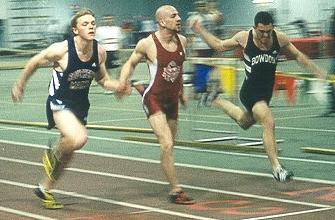
|
Lynne Bermel's Column |
July 6, 2001
Ottawa Needs an Indoor Track!
With scores of bike paths, parks, playing fields, arenas, pools, gyms and the world's longest skating rink, it's no wonder Ottawa is considered a fit capital. It boasts the largest recreation populace per capita.
Ottawa is also one of the coldest capital cities in the world. Which is why it so strange that this in this city of 800,000, there isn't a single indoor track.
The National Capital Race Weekend, drawing a record 13,0000 this year, showed that there are a large number of area residents who are runners. Cities half Ottawa's size have indoor tracks and their winters are far more hospitable. It's not just a question of getting a little cold out there during those endless winter months - it's a question of falling on streets and sidewalks that have turned into skating rinks.
"Every major city in Canada, except Ottawa, has at least one indoor track," says Ken Parker, coach of the Ottawa Athletic Club Racing Team. "Why Ottawa, which is one of the more affluent cities in Canada, does not have an indoor track is very puzzling."
Right now, the sole track in the city is the 125 metre rubberized surface at the private club, the OAC.
Once upon a time, the city once had a 150M flat track at the Coliseum building at Lansdowne Park. There was also a 50M sprint straightaway, and facilities for high jumping, long jumping and pole vaulting. When the Ottawa Indoor Games started, the 200M flat track was replaced with a banked 125M one. This was moved to the Civic Centre for the Games and returned to the Coliseum for training. The Coliseum facility was used for local and eastern regional track meets as well as training.
The City took out the track and signed a deal with an organization to use the Coliseum for indoor soccer.
"To my knowledge there was no consultation with the local track and running community. They just did it, kicking the sport of track and field out into the winter." Says Parker.
Bob Chiarelli expressed support for an indoor facility prior to, and after his election as Mayor of the New City. A meeting with the City was held with a number of track lobby people present. The City committed to the hiring of a consultant to examine all possible options - short term long term, existing building, bubble, new building, associated costs, possible revenue streams, etc.
For some reason, the timetable has slipped substantially and it now appears that Ottawa will once again go through another winter without a facility.
"I cannot understand why the City is being so apathetic to a particular sports group. We have many arenas, swimming pools, and sports fields but are lacking a facility for the biggest Olympic sport. "
One of the biggest casualties of not having an indoor facility is the Ottawa Lions Club, ranked in the top 10 in Canada for the past decade.
Jim Slepica, Coach and Director of Programs says his higher caliber athletes are forced to go to other training venues in the States at their own expense during Ottawa's winters. "Glenroy Gilbert hasn't spent a winter here in 7 or 8 years." Distance star Sean Kaley is stationed permanently in Arkansas because of the situation here.
One makeshift solution has been to train in the wind tunnel at Carleton University. While it provides a long stretch for sprinting, concrete is the worst possible surface an athlete can run on. "It's a trade-off," says Slepica. "It's unfortunate that it has come down to this: Athletes are prepared to take the risk if it means not getting in their training."

Slepica's sprinters have also trained on the high-speed treamill at the Corel Centre. Not a perfect solution either. Fifty per cent have ended up getting some kind of injury he says. "It's not forgiving. At 25 to 26 miles an hour, if you get tired or one misstep, you could be slung out the back like a slingshot."
This winter, the Lions trained on 1/3 of the artificial turf they rented at the Dome at Lansdowne Park. With up to 120 athletes out a practice, it wasn't ideal for the confined area, particularly for field events.
"I don't mean to sound negative or pessimistic, " says Slepica. "It's just I don't think people can conceive of how far a permanent indoor facility would reach here in Ottawa."
Slepica says people can't get enough soccer fields or hockey rinks. He envisions a fully integrated multi-sport building with a track and facilities to accommodate a range of programs. He believes with user fees it would be self-sustaining.
Phil Marsh, Manager of the Running Room, says that while the needs of the elite athletes have to be accommodated, it's the grassroots movement that will drive and sustain the program. By strength of numbers, school groups, fitness organizations, the disabled, elderly, heart patients, corporate types should be brought into the process.
Adds Leslie Estwick, a top ranked world masters track and field athlete, "We need something that meets the needs of a large group of people in one place. That's how people get introduced to a new sport and encouraged to try it. Every school kid in Ottawa used to know about and look forward to the Ottawa Citizen Indoor Games."
Contact Lynne via email @ lynnebermel@home.com
For more on Lynne's background read this interview with Wayne Scanlan which appeared originally in the Ottawa Citizen.
Top of Article